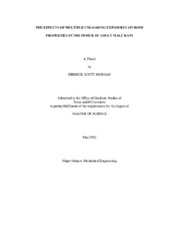| dc.description.abstract | NASA goals include long-term International Space Station (ISS) missions and the ambitious objective of eventually sending astronauts to Mars. Unfortunately, exposure to unloading due to microgravity during spaceflight has been shown to cause detrimental health effects on bone. Therefore, NASA is seeking a ground-based animal model to study the long-term effects of unloading on bone in order to better insure the health and mission capability of astronauts. The hindlimb unloaded (HU) rat model was used to study the effects of multiple unloading exposures and aging on bone properties. Six month old, adult, male Sprague-Dawley rats were separated into the following groups: baseline (BL, sacrificed when received at 6 months age), aging cage control (AC, normal weight-bearing cage activity), 1HU7 (unloaded for 1 month starting at 7 months of age and allowed to recover for 3 months), 1HU10 (normal cage activity until 10 months of age, unloaded for 1 month, recovered for 2 months), and 2HU10 (unloaded for 1 month at 7 months of age, allowed to recover for 2 months, unloaded again for 1 month at 10 months of age, followed by 2 months of recovery). Every 28 days a subset of animals (n=15) were euthanized and both femurs were excised. A peripheral quantitative computed tomography (pQCT) scanner was used to collect densitometric and geometric properties at the right and left femoral neck and at the left femoral midshaft. Mechanical testing (axial and lateral compression of the femoral neck and 3pt bending of the midshaft) was performed at each location and strength indices based on pQCT parameters were calculated.
Femoral neck properties decreased due to HU but recovered with respect to increase over HU, BL, and AC by the end of the recovery periods. Femoral midshaft properties were relatively unaffected, but did show slight decreases for older animals at month 10, which recovered during the two month recovery period. Femoral neck geometry exhibited increased endocortical resorption and periosteal apposition of the cortical shell which suggests that trabecular bone plays an important role in how the total bone is affected by HU. Densitometric properties were affected less by HU with respect to BL than were mechanical strength values. Results suggest that femoral neck is more affected by unloading than midshaft, particularly for multiple exposures of unloading. Also, aging does not appear to be a critical factor for bone loss due to HU for either femoral neck or midshaft. | en |


